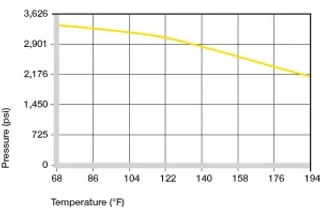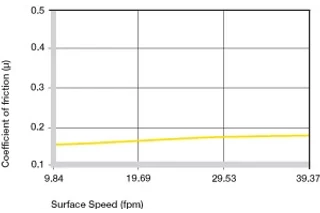Change Language :
iglide® J200 - Material data
| General features | Unit | iglide® J200 | Test method |
|---|---|---|---|
| Density | g/cm³ | 1.72 | |
| Color | Dark gray | ||
| Max. moisture absorption at 73° F/50% R. H. | Wt.-% | 0.2 | DIN 53495 |
| Max. moisture absorption | Wt.-% | 0.7 | |
| Coefficient of friction, dynamic against steel | µ | 0.11 - 0.17 | |
| p x v value, max. (dry) | psi x fpm | 8,600 |
| Mechanical properties | Unit | iglide® J200 | Test method |
|---|---|---|---|
| Modulus of elasticity | psi | 406,100 | DIN 53457 |
| Tensile strength 68° F | psi | 8,412 | DIN 53452 |
| Compressive Strength | psi | 6,237 | |
| Permissible static surface pressure (68° F) | psi | 3,336 | DIN 53505 |
| Shore D hardness | 70 |
| Physical and thermal properties | Unit | iglide® J200 | Test method |
|---|---|---|---|
| Upper long-term application temperature | °F | 194 | |
| Upper short-term application temperature | °F | 248 | |
| Lower application temperature | °F | -58 | |
| Thermal conductivity | [W/m x K] | 0.24 | ASTM C 177 |
| Coefficient of thermal expansion (at 73° F) | [K^(-1) x 10^(-5) ] | 8 | DIN 53752 |
| Electrical properties | Unit | iglide® J200 | Test method |
|---|---|---|---|
| Specific volume resistance | Ωcm | > 10^8 | DIN IEC 93 |
| Surface resistance | Ω | > 10^8 | DIN 53482 |

Permissible p x v values for iglide® J200
Permitted p x v values
For iglide® J200 plastic bushings running dry against a steel shaft, at 68° F
iglide® J200 is the result of the development of a particularly low-friction plastic bushings. The friction plays a crucial role particularly in linear applications. Whereas many materials have excellent coefficients of friction under high loads, iglide® J200 is characterized by its property to retain very good coefficients of friction in low loads as well.
Among all the iglide® materials, iglide® J200 exhibits the lowest coefficients of friction. The average coefficient of friction of all measurements, even with different shaft materials, is 0.11. For this reason the hard-anodized aluminum counter partner gains special significance.

Figure 27.2: Deformation under load and temperatures
Surface pressure
The comparison with the rest of the iglide® materials makes it clear that iglide® J200 plastic bushings are suitable for rather low loads.
Figure 27.2 shows the expansion of the materials from room temperature up to the recommended maximum limit. Like all thermoplastics, the compression strength declines above the temperature. This is shown in Figure 27.3.
Permitted surface speeds
iglide® J200 attains high surface speeds through its excellent coefficients of friction. Continuous rotary speeds of 197 fpm are possible. The permitted speeds are clearly higher yet in linear movements or in short-term operation. Speeds of over 2953 fpm were successfully tested in linear movements.
Maximum surface speed
| fpm | Rotating | Oscillating | Linear |
|---|---|---|---|
| Constant | 197 | 137 | 1969 |
| Short-term | 295 | 216 | 2953 |
Temperatures

Figure 27.3: Maximum recommended surface pressure dependent on the temperature
The plastic bushings made of iglide® J200 were not developed for high temperatures. The maximum permitted temperature of 248° F should not be exceeded. Thereby the ambient temperature generated by friction has to be added. From 140° F onward, the bushings should be mechanically fastened, so that the danger of bushings creeping out of the bores is avoided. The wear resistance too declines disproportionately from 158° F.
| iglide® J200 | Application temperature |
|---|---|
| Lower | - 58 °F |
| Upper, long-term | + 194 °F |
| Upper, short-term | + 248 °F |
| Additional axial securing | + 140 °F |
Friction and wear

Figure 2.4: Coefficients of friction dependent on the surface speed, p =108 psi
Friction is the main argument for the application of plastic bushings made of iglide® J200. The friction of this bushing is more favorable with numerous shaft materials than that of any other iglide® plastic bushing.
The influence of the shaft is in contrast very large in wear resistance. It is worth taking a look, even at low loads, at the extensive measurement results of the conducted tests.
The graphs clarify this statement. The wear resistance of the bushing is exceptionally good up to the limit load of 3,336 psi, which makes the bushing better suited for rotating applications.
| iglide® J200 | Dry | Grease | Oil | Water |
|---|---|---|---|---|
| Coefficients of friction µ | 0.11 - 0.17 | 0.09 | 0.04 | 0.04 |

Fig. 2.7: Wear, rotating application with different shaft materials, load p = 108 psi, v = 98 fpm
Shaft Materials
The used shaft material has a large influence on the wear resistance. All shaft materials (soft or hardened) are indeed suitable for application with iglide® J200. However the best results are attained with hard-anodized aluminum. This counter partner has proved itself particularly in linear movements.
Installation tolerances
iglide® J200 plastic bushings are standard bushings for shafts with h-tolerance (recommended minimum h9).
After the installation in a housing bore with H7 tolerance, the inner diameter of the bushing automatically adjusts to the E10 tolerance.
| Diameter d1 [inch] | Shaft h9 [inch] | iglide® J200 E10 [inch] |
|---|---|---|
| Up to 0.019685 | 0 - 0.0009843 | +0.0005512 + 0.0021259 |
| > 0.1181 to 0.2362 | 0 - 0.0011811 | +0.0007874 + 0.0026772 |
| > 0.2362 to 0.3937 | 0 - 0.0014173 | +0.0009843 + 0.0032677 |
| > 0.3937 to 0.7087 | 0 - 0.0016929 | +0.0012598 + 0.0040157 |
| > 0.7087 to 1.1811 | 0 - 0.0020472 | +0.0015748 + 0.0048819 |
| > 1.1811 to 1.9685 | 0 - 0.0024409 | +0.0019685 + 0.0059055 |
Chemical resistance
iglide® J200 plastic bushings are resistant to diluted alkalis as well as to solvents and all kinds of lubricants. The humidity absorption of iglide® J200 plastic bushings amounts to about 0.2% in standard climatic conditions. The saturation limit in water is 0.7%. These values are so low that a moisture expansion need to be considered only in extreme cases.
+ resistant
0 conditionally resistant
- non-resistant
| Medium | Resistance |
|---|---|
| Alcohol | + |
| Hydrocarbons, chlorinated | + |
| Greases, oils, without additives | + |
| Fuels | + |
| Weak acids | 0 to - |
| Strong acids | - |
| Weak alkaline | + |
| Strong alkaline | + to 0 |

Influence of moisture absorption of iglide® J200 plastic bushings
Radioactive rays
iglide® J200 plastic bushings are radiation resistant up to a radioactive intensity of 3 x 10² Gy.
UV-resistant
iglide® J200 plastic bushings are very resistant to the influence of UV rays.
Vacuum
The use in vacuum is possible only conditionally. Only dry plastic bushings made of iglide® J200 should be tested in vacuum.
Delivery program
The iglide® J200 plastic bushings are manufactured according to order specifications.
Electrical properties
Plastic bushings made of iglide® J200 are electrically insulating.
| Specific volume resistance | > 10^8 Ωcm |
| Surface resistance | > 10^8 Ω |



